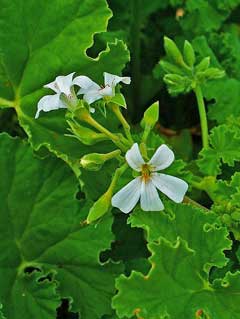
Apple Geranium
Latin Name: Pelargonium odoratissimum
USDA Hardiness: 8-11
Native Range: AFRICA: South Africa (Cape Province, KwaZulu-Natal, Transvaal)
Edibility Rating: 2 / 5
Medicinal Rating: 3 / 5
Region:
Family:
Plant Type:
Medicinal Uses
Edible Uses
Edible Parts: | Edible Uses: Condiment TeaThe leaves are crushed and used to flavour salads, soups, fruit dishes, jellies, sorbets, ice-cream, cakes etc[183, 238]. Cake pans can be lined with the leaves and the pastry will be infused with their essence[183]. The leaves have an apple scent according to one report[183] but our plants have a very strong minty smell[K]. An infusion of the leaves is used as a tea[238].
Cultivation
An easily grown plant, succeeding in a well-drained ordinary good soil[260, K]. Requires a light well-drained neutral to alkaline soil in a sunny position[188, 200]. Plants are tolerant of some shade[238]. Plants are not very cold-hardy in Britain, tolerating temperatures down to about -3°c[260]. They generally require greenhouse protection but might succeed outdoors when grown in a very sheltered warm spot in the mildest parts of the country[1]. They can also be grown in containers that are placed outdoors in the summer and then brought into the greenhouse or conservatory for the winter[238]. The plants need to be kept fairly dry in the winter[200]. When grown in pots, the plants require regular repotting in order to stay vigorous[260]. Very tolerant of pruning, they can be cut right down to the base in the autumn when bringing them back indoors, or in the spring to encourage lots of fresh growth[238]. The bruised leaves release a smell of ripe apples[245]. The plant is cultivated for its essential oil[171].
Known Hazards
None known
Habitats
Shady places and under trees in forest margins in eastern and southern Cape areas[260].
